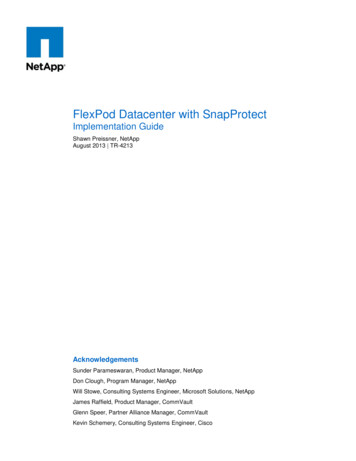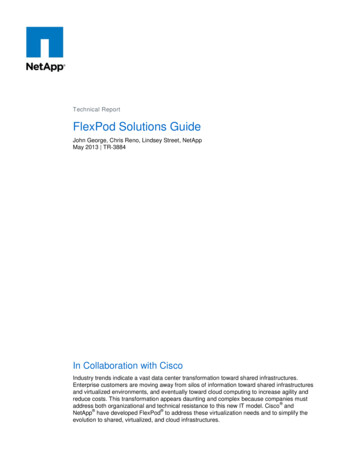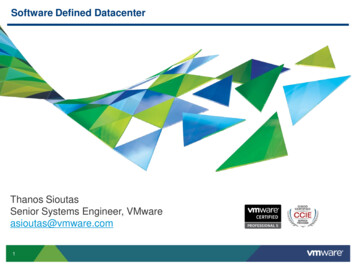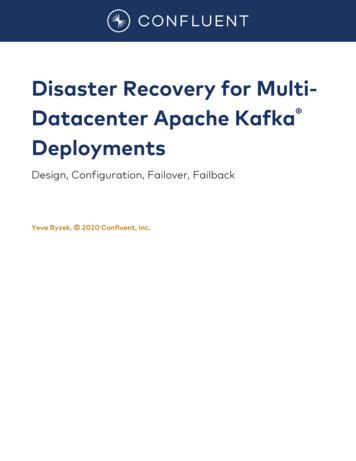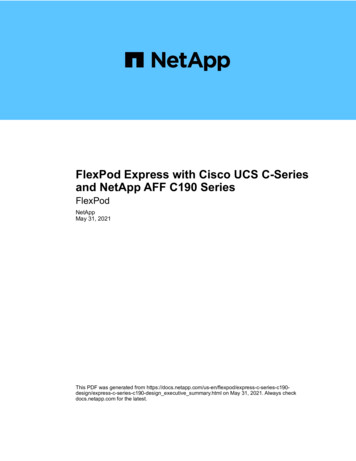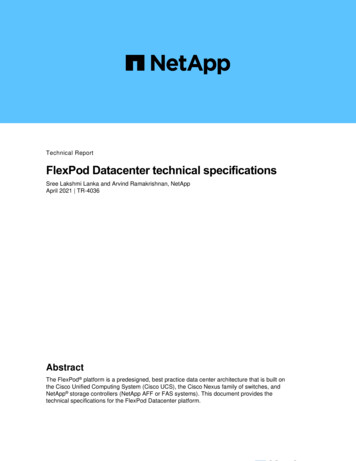
Transcription
Technical ReportFlexPod Datacenter technical specificationsSree Lakshmi Lanka and Arvind Ramakrishnan, NetAppApril 2021 TR-4036AbstractThe FlexPod platform is a predesigned, best practice data center architecture that is built onthe Cisco Unified Computing System (Cisco UCS), the Cisco Nexus family of switches, andNetApp storage controllers (NetApp AFF or FAS systems). This document provides thetechnical specifications for the FlexPod Datacenter platform.
TABLE OF CONTENTSSolution overview . 6FlexPod platforms . 6FlexPod rules . 6Supported versus validated FlexPod configurations . 6NetApp ONTAP . 7Cisco Nexus Switching modes of operation . 7Minimum hardware requirements . 7Minimum software requirements . 8Connectivity requirements. 8FlexPod management with Cisco Intersight . 9Intersight Managed Mode. 10Other requirements . 10Optional features . 11MetroCluster .11End-to-end FC-NVMe .13FC SAN boot through Cisco MDS .14FC SAN boot with Cisco Nexus .15FCoE SAN boot option .16iSCSI boot option.18Cisco UCS Direct Connect with NetApp storage .19Cisco components . 22Cisco UCS Fabric Interconnect options .22Cisco UCS B-Series Chassis option .22Cisco UCS B-Series Blade Server options .23Cisco UCS C-Series Rack Server options .23Cisco Nexus 5000 Series Switch options .24Cisco Nexus 7000 Series Switch options .24Cisco Nexus 9000 Series Switch options .24Cisco APIC options.25Cisco Nexus Fabric Extender options .25Cisco MDS options .252FlexPod Datacenter Technical Specifications 2021 NetApp, Inc. All Rights Reserved.
Cisco software licensing options.25Cisco support licensing options .26NetApp components . 26NetApp storage controller options .26Cluster interconnect switch options .26NetApp disk shelf and drive options .27NetApp software licensing options.27NetApp Support licensing options.27Power and cabling requirements . 28Power requirements .28Minimum cable requirements.28Technical specifications and references. 29Cisco UCS B-Series Blade Server chassis .29Cisco UCS B-Series Blade Servers .30Cisco UCS C-Series Rack Servers.30GPU recommendation for FlexPod AI, ML, and DL .30Cisco UCS VIC adapters for Cisco UCS B-Series Blade Servers .31Cisco UCS Fabric Interconnects.31Cisco Nexus 5000 Series Switches .31Cisco Nexus 7000 Series Switches .32Cisco Nexus 9000 Series Switches .32Cisco Application Policy Infrastructure Controller .32Cisco Nexus Fabric Extender details .32SFP modules .33NetApp storage controllers .33Legacy equipment . 34Where to find additional information . 35Version history . 35LIST OF TABLESTable 1) Cisco UCS Fabric Interconnect options. .22Table 2) Cisco UCS B-Series chassis option. .22Table 3) Cisco UCS B-Series Blade Server options. .23Table 4) Cisco UCS C-Series chassis option. .233FlexPod Datacenter Technical Specifications 2021 NetApp, Inc. All Rights Reserved.
Table 5) Cisco UCS C-Series Rack Server options. .23Table 6) Cisco Nexus 5000 Series Switch options. .24Table 7) Cisco Nexus 7000 Series Switch options. .24Table 8) Cisco Nexus 9000 Series Switch options. .24Table 9) Cisco Nexus FEX options. .25Table 10) Cisco MDS switches. .25Table 11) Cisco software licensing options. .25Table 12) Cisco support licensing options. .26Table 13) NetApp storage controller options. .26Table 14) Cluster interconnect switch options. .27Table 15) NetApp disk shelf options. .27Table 16) NetApp software licensing options. .27Table 17) NetApp Support licensing options. .27Table 18) Minimum cable requirements. .28Table 19) Cisco UCS B-Series Blade Server chassis options. .29Table 20) Cisco UCS B-Series Blade Server datasheets. .30Table 21) C-Series Rack Server datasheets. .30Table 22) C-Series Rack Servers for AI, ML, and DL. .30Table 23) Cisco UCS VIC adapter datasheets. .31Table 24) Cisco UCS fabric interconnect datasheets. .31Table 25) Cisco Nexus 5000 Series Switch datasheets. .31Table 26) Cisco Nexus 7000 Series Switch datasheets. .32Table 27) Cisco Nexus 9000 Series Switch datasheets. .32Table 28) Cisco APIC technical specifications. .32Table 29) Cisco Nexus 2000 Series FEX datasheet. .33Table 30) NetApp FAS Series datasheets. .33Table 31) NetApp AFF A-Series datasheets. .34Table 32) NetApp disk shelves. .34LIST OF FIGURESFigure 1) FlexPod Datacenter with NetApp MetroCluster architecture. .12Figure 2) FlexPod Datacenter with NetApp MetroCluster IP architecture. .13Figure 3) FlexPod Datacenter for FC with Cisco MDS. .13Figure 4) FlexPod Datacenter for FC with Cisco MDS. .14Figure 5) FlexPod Datacenter for FC with Cisco Nexus 93180YC-FX. .15Figure 6) FC boot scenario. .16Figure 7) FCoE boot scenario. .18Figure 8) iSCSI boot scenario. .19Figure 9) FC direct-connect scenario. .204FlexPod Datacenter Technical Specifications 2021 NetApp, Inc. All Rights Reserved.
Figure 10) iSCSI/Unified IP direct-connect scenario. .215FlexPod Datacenter Technical Specifications 2021 NetApp, Inc. All Rights Reserved.
Solution overviewThe FlexPod platform is a predesigned, best practice data center architecture that is built on the CiscoUnified Computing System (Cisco UCS), the Cisco Nexus family of switches, and NetApp storagecontrollers (NetApp AFF or FAS systems).FlexPod is a suitable platform for running a variety of virtualization hypervisors as well as bare-metaloperating systems and enterprise workloads. FlexPod delivers not only a baseline configuration, but alsothe flexibility to be sized and optimized to accommodate many different use cases and requirements.Note:Before you order a complete FlexPod configuration, see the FlexPod Converged Infrastructurepage on netapp.com for the latest version of these technical specifications.FlexPod platformsThere are two FlexPod platforms: FlexPod Datacenter. This platform is a massively scalable virtual data center infrastructure that issuited for workload enterprise applications; virtualization; virtual desktop infrastructure (VDI); andpublic, private, and hybrid cloud workloads. FlexPod Express. This platform is a compact converged infrastructure that is targeted to remoteoffice and edge use cases. FlexPod Express has its own specifications that are documented in theFlexPod Express Technical Specifications.This document provides the technical specifications for the FlexPod Datacenter platform.FlexPod rulesThe FlexPod design enables a flexible infrastructure that encompasses many different components andsoftware versions.Use the rule sets as a guide for building or assembling a valid FlexPod configuration. The numbers andrules that are listed in this document are the minimum requirements for a FlexPod configuration. They canbe expanded in the included product families as required for different environments and use cases.Supported versus validated FlexPod configurationsThe FlexPod architecture is defined by the set of rules that are described in this document. The hardwarecomponents and software configurations must be supported by the Cisco UCS Hardware and SoftwareCompatibility List and the NetApp Interoperability Matrix Tool (IMT).Each Cisco Validated Design (CVD) or NetApp Verified Architecture (NVA) is a possible FlexPodconfiguration. Cisco and NetApp document these configuration combinations and validate them withextensive end-to-end testing. The FlexPod deployments that deviate from these configurations are fullysupported if they follow the guidelines in this document and if all the components are listed as compatiblein the Cisco UCS Hardware and Software Compatibility List and the NetApp IMT.For example, adding more storage controllers or Cisco UCS Servers and upgrading software to newerversions are fully supported if the software, hardware, and configurations meet the guidelines that aredefined in this document.6FlexPod Datacenter Technical Specifications 2021 NetApp, Inc. All Rights Reserved.
NetApp ONTAPNetApp ONTAP data management software is installed on every NetApp FAS or AFF system. FlexPodis validated with ONTAP software, providing a highly scalable storage architecture that enablesnondisruptive operations, nondisruptive upgrades, and an agile data infrastructure.For more information about ONTAP, see the ONTAP Data Management Software product page.Cisco Nexus Switching modes of operationA variety of Cisco Nexus products can be used as the switching component of a given FlexPoddeployment. Most of these options leverage the traditional Cisco Nexus OS or NX-OS software. TheCisco Nexus family of switches offers varying capabilities within its product lines. These capabilities aredetailed later in this document.Cisco’s offering in the software-defined networking space is called Application Centric Infrastructure(ACI). The Cisco Nexus product line that supports the ACI mode, also called fabric mode, is the CiscoNexus 9300 series. These switches can also be deployed in NX-OS or standalone mode.Cisco ACI is targeted at data center deployments that focus on the requirements of a specific application.Applications are instantiated through a series of profiles and contracts that allow connectivity from thehost or virtual machine (VM) all the way through the network to the storage.FlexPod is validated with both modes of operation of the Cisco Nexus switches. For more informationabout the ACI and the NX-OS modes, see the following Cisco pages: Cisco Application Centric Infrastructure Cisco NX-OS SoftwareMinimum hardware requirementsA FlexPod Datacenter configuration has minimum hardware requirements, including, but not limited to,switches, fabric interconnects, servers, and NetApp storage controllers.You must use Cisco UCS Servers. Both C-Series and B-Series Servers have been used in the validateddesigns. Cisco Nexus Fabric Extenders (FEXs) are optional with C-Series Servers.A FlexPod configuration has the following minimum hardware requirements: Two Cisco Nexus switches in a redundant configuration. This configuration can consist of tworedundant switches from the Cisco Nexus 5000, 7000, or 9000 Series. The two switches should be ofthe same model and should be configured in the same mode of operation.Note:If you are deploying an ACI architecture, you must observe the following additionalrequirements: Deploy the Cisco Nexus 9000 Series Switches in a leaf-spine topology. Use three Cisco Application Policy Infrastructure Controllers (APICs). Two Cisco UCS 6200, 6300, or 6400 Series Fabric Interconnects in a redundant configuration. Cisco UCS Servers:7 If the solution uses B-Series Servers, one Cisco UCS 5108 B-Series Blade Server Chassis plustwo Cisco UCS B-Series Blade Servers plus two 2104, 2204/8, 2408, or 2304 I/O modules(IOMs). If the solution uses C-Series Servers, two Cisco UCS C-Series Rack Servers.FlexPod Datacenter Technical Specifications 2021 NetApp, Inc. All Rights Reserved.
Note: For larger deployments of Cisco UCS C-Series Rack Servers, you can choose a pair of2232PP FEX modules. However, the 2232PP is not a hardware requirement.Two NetApp storage controllers in a high-availability (HA) pair configuration:Note: This configuration can consist of any supported NetApp FAS or AFF series storagecontrollers. See the NetApp Hardware Universe application for a current list of supported FASand AFF controller models. The HA configuration requires two redundant interfaces per controller for data access; theinterfaces can be FCoE, FC, or 10Gb Ethernet (10GbE). If the solution uses NetApp ONTAP, a cluster interconnect topology that is approved by NetApp isrequired. For more information, see the Switches tab of the NetApp Hardware Universe. If the solution uses ONTAP, at least two additional 10GbE ports per controller are required fordata access. For ONTAP clusters with two nodes, you can configure a two-node switchless cluster. For ONTAP clusters with more than two nodes, a pair of cluster interconnect switches arerequired.One NetApp disk shelf with any supported disk type. See the Shelves tab of the NetApp HardwareUniverse for a current list of supported disk shelf models.Minimum software requirementsA FlexPod configuration has the following minimum software requirements: NetApp ONTAP: ONTAP software version requires ONTAP 9.1 or laterCisco UCS Manager (UCSM) releases: Cisco UCS 6200 Series Fabric Interconnect—2.2(8a) Cisco UCS 6300 Series Fabric Interconnect—3.1(1e) Cisco UCS 6400 Series Fabric Interconnect--- 4.0(1) For Cisco Nexus 5000 Series Switches, Cisco NX-OS software release 5.0(3)N1(1c) or later,including NX-OS 5.1.x For Cisco Nexus 7000 Series Switches: The 4-slot chassis requires Cisco NX-OS software release 6.1(2) or later The 9-slot chassis requires Cisco NX-OS software release 5.2 or later The 10-slot chassis requires Cisco NX-OS software release 4.0 or later The 18-slot chassis requires Cisco NX-OS software release 4.1 or laterFor Cisco Nexus 9000 Series Switches, Cisco NX-OS software release 6.1(2) or laterNote:The software that is used in a FlexPod configuration must be listed and supported in theNetApp IMT. Some features might require more recent releases of the software than the onesthat are listed.Connectivity requirementsA FlexPod configuration has the following connectivity requirements: A separate 100Mbps Ethernet/1Gb Ethernet out-of-band management network is required for allcomponents.8FlexPod Datacenter Technical Specifications 2021 NetApp, Inc. All Rights Reserved.
NetApp recommends that you enable jumbo frame support throughout the environment, but it is notrequired. The Cisco UCS Fabric Interconnect appliance ports are recommended only for iSCSI and NASconnections. No additional equipment can be placed in line between the core FlexPod components.Uplink connections: The ports on the NetApp storage controllers must be connected to the Cisco Nexus 5000, 7000, or9000 Series Switches to enable support for virtual port channels (vPCs). vPCs are required from the Cisco Nexus 5000, 7000, or 9000 Series Switches to the NetApp storagecontrollers. vPCs are required from the Cisco Nexus 5000, 7000, or 9000 Series Switches to the fabricinterconnects. A minimum two connections are required for a vPC. The number of connections within a vPC can beincreased based on the application load and performance requirements.Direct connections: NetApp storage controller ports that are directly connected to the fabric interconnects can be groupedto enable a port channel. vPC is not supported for this configuration. FCoE port channels are recommended for end-to-end FCoE designs.SAN boot: FlexPod solutions are designed around a SAN-boot architecture using iSCSI, FC, or FCoE protocols.Using boot-from-SAN technologies provides the most flexible configuration for the data centerinfrastructure and enables the rich features available within each infrastructure component. Althoughbooting from SAN is the most efficient configuration, booting from local server storage is a valid andsupported configuration. SAN boot over FC-NVME is not supported.FlexPod management with Cisco IntersightCisco Intersight is a cloud operations platform that delivers intelligent visualization, optimization, andorchestration for applications and infrastructure across your hybrid environment.Cisco UCS devices, NetApp ONTAP Storage, and VMware Hypervisor can now be monitored andmanaged from Cisco Intersight. The following components are required to enable management fromCisco Intersight Cisco Intersight Virtual Appliance: Cisco Intersight Virtual Appliance delivers the management features of Intersight for Cisco UCSand NetApp Storage (through NetApp ONTAP Connector developed for Intersight VirtualAppliance) in an easy-to-deploy VMware OVA, Microsoft Hyper-V Server VM, and KVMhypervisor that allows you to control which system details leave your premises. The VirtualAppliance form factor enables additional data locality, security, or compliance needs that are notcompletely met by intersight.com. You can deploy Cisco Intersight Virtual Appliance in one of thefollowing modes: Intersight Connected Virtual Appliance Intersight Private Virtual Appliance Intersight AssistNetApp Active IQ Unified Manager 9.8P1 and later:9FlexPod Datacenter Technical Specifications 2021 NetApp, Inc. All Rights Reserved.
NetApp Active IQ Unified Manager acts as a management gateway to manage and orchestrateNetApp ONTAP storage resources from Cisco Intersight. Active IQ Unified Manager administersthe ONTAP storage clusters and enables automation by using Unified Manager’s Rest APIservices.NetApp ONTAP 9.7P1 and later: NetApp ONTAP software 9.7P1 and later are supported.NetApp storage arrays: All ONTAP AFF and FAS storage arrays supported for ONTAP 9.7P1 and later.Virtualization hypervisor: VMware vSphere 6.7 and later are supported.Cisco Intersight licensing: Cisco Intersight is licensed on a subscription basis with multiple license editions from which tochoose. Capabilities increase with the different license types. You can purchase a subscriptionduration of one, three, or five years and choose the required Cisco UCS Server volume tier forthe selected subscription duration. Each Cisco endpoint automatically includes a Cisco IntersightBase at no additional cost when you access the Cisco Intersight portal and claim a device. Youcan purchase any of the following higher tier Intersight licenses using the Cisco ordering tool: Cisco Intersight Essentials. The Essentials tier includes all functionality of the Base tier butwith additional features including Cisco UCS Central and Cisco IMC Supervisor entitlement,policy-based configuration with Service Profiles, firmware management, and evaluation ofcompatibility with the Hardware Compatibility List (HCL). Cisco Intersight Advantage. The Advantage tier offers all the features and functionality ofthe Base and Essentials tiers. It includes storage widgets, storage inventory, storagecapacity, and storage utilization, and cross-domain inventory correlation across physicalcompute, physical storage, and virtual environments (VMware ESXi). Cisco Intersight Premier. In addition to the capabilities provided in the Advantage tier, theCisco Intersight Premier tier offers private cloud infrastructure-as-a-Service (IaaS)orchestration across Cisco UCS and third-party systems, including VMs (VMware vCenter)and physical storage (NetApp storage).Note:For more information about the features covered by various licensing tiers, see the CiscoLicensing page.For more information about the requirements, see TR-4883: FlexPod Datacenter with ONTAP 9.8,ONTAP Storage Connector for Cisco Intersight, and Cisco Intersight Managed Mode.Inters
If the solution uses NetApp ONTAP, a cluster interconnect topology that is approved by NetApp is required. For more information, see the Switches tab of the NetApp Hardware Universe. If the solution uses ONTAP, at least two additional 10GbE ports per controller are required for data access.

